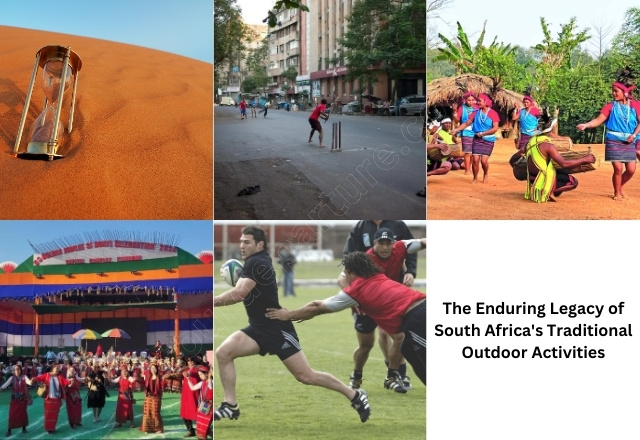South Africa, a land endowed with stunning landscapes and predominantly good-tempered people, is the perfect setting for adventurers and lovers of outdoor activities. However, the South African outdoors is not limited to adventure tourism and organized sports to enjoy the sunshine. Apart from the excitement and orderly competition, there is a rich array of traditional and social outdoor games that include people of all ages. These games are not idle pastimes, but are monuments to South Africa’s diverse culture, encouraging exercise, interaction, and togetherness. Let’s delve deeper into some of the most popular outdoor games enjoyed across the Rainbow Nation
- Diketo (Uphuca): A Timeless Test of Skill
This game is known in Sotho-Tswana as Diketo, isiXhosa as Isiputho or Uphuca in Zulu, and can be described as a simple and yet challenging game of speed and coordination. To be played with marbles on a drawn circle in the dirt or a shallow hole, diketo involves flicking your own small marbles with the thumb to knock out your opponent’s. They have different rules depending on the area of the geographical world where they are played. Some of them involve players tossing or throwing their marbles towards their opponent while in others, players have to aim and get the marbles to fall in the circle so that they can have a chance to eliminate the opponent’s marbles. The objectives are achieved on the basis of capturing as many marbles as possible, which makes the basic action of flicking strategic. Diketo is not only a game but is part of the culture in which from one generation to another child learn the flick from their parents.
- Ntimo/Kgati/Ugqaphu: A Rhythmic Explosion of Energy
This depends on the region where it’s being played, it could be referred to as Ntimo, Kgati or Ugqaphu, nevertheless, this game entails vigorous movements that make it exciting for any event. A cross between a jump rope and a hi-energy dance, Ntimo involves singing, clapping and various tricks as players try to maneuver themselves to jump through the swinging rope. The jump rope itself, which is usually made of a piece of leather or mielie cobs string, has a distinctly African feel. The singing sets the pace for the jumpers and the lyrics, at times, are provocative or congratulatory to the participants. Kgati is most characterized by fancy footwork where players kick their legs high, hop on one leg, or even emulate break dancers by splitting their legs while over the rope. This is a dynamic game that involves coordination, rhythmic movements and stamina, thus offering an excellent opportunity for laughter and exercise.
- Street Cricket: Keeping the Spirit Alive: Cricket
One of South Africa’s favorite summer pastimes is cricket and it has a more amateur sibling, that is street cricket. In street cricket, you often see players using rudimentary equipment such as bricks or stones to create a wicket, a tennis ball and anything that could mimic a cricket bat – a broomstick, for instance, or a piece of cardboard that has been rolled up. The beauty of street cricket is found in the fact that it can be played anywhere and with anything. Players can range from two to eleven, the size of the pitch can vary depending on the size of the area available, and the rules can also be altered depending on the age and ability of the players. This informality enables anyone to capture a piece of wood and have a feel of the game making the spirit of cricket remain alive with every street.
- Isiphindi:A Strategic Contest Steeped in Tradition
This is a native South African game and is also called sticks or intfwalo and involves a lot of outwit, planning and concentration. Isiphindi is a game played with pointed sticks manipulating the dirt “board” which has been drawn on the ground with lines and holes and the objective of the game is to flick and maneuver the sticks to capture the opponent’s pieces. Like mancala, it is an Indigenous South African game that is thought to have started among the Nguni people centuries ago. Isiphindi is not only a game but can be regarded as a means of bringing players closer to their cultural roots and enhancing their pride. It is easy to play and can be played anytime and anywhere from under a tree to in the middle of a market.
- Touch Rugby: A Friendly Face of a Beloved Sport
Touch rugby is an excellent option for those, who would like to experience the dynamics of rugby without dangerous hits. Different from regular rugby, touch rugby is usually performed on a limited field with fewer participants; the focus is made on dexterity, cooperation, and passing. The main focus of the game is to run into the player with the ball and take it from him with your hand; thus, it is a simplified version of the game. Touch rugby is ideal as a fun game to be played at the park or the beach as it makes rugby more accessible and engaging for all ages and fitness levels.
Social and Physical Benefits
Apart from fun, these outdoor games are of many advantages to the players. They promote exercise, foster hand-eye coordination and problem-solving skills, and enhance interpersonal relations. They depict how the society, especially South Africans, make the best out of what is around them in creating traditions and memories.
Games with Deep Roots and Cultural Significance
Among them are some that originated from the earliest history and culture of South Africa. For example Isiphidi is said to have been found in the Nguni tribe several centuries ago. Through such games, players can easily associate with their roots making them proud of their past.

